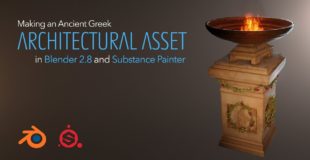https://i.ytimg.com/vi/TcfM79ST9TA/hqdefault.jpg
The Spartan Warrior Modeling course: http://gumroad.com/l/spartanmodelingcourse
Download the Reference Images here: http://www.heroesofbronze.com/news/2018/12/21/new-architectural-asset-tutorial-series
Architectural Asset series Part 2: http://youtu.be/b0anQC-BLPY
For the complete list of keyboard shortcuts:
https://www.heroesofbronze.com/news/2018/12/21/new-architectural-asset-tutorial-series
Get the procedural fire shader B’rn from Simon Thommes here: https://gumroad.com/l/BRNbl
Let’s start a new tutorial series! This time aimed at beginner Blender users, explaining the modeling process for this short film asset.
In the future parts you will learn how to create particles of leaves and flowers, sculpt a few engravings, UV the asset, add fire and render it. We will be also texturing it in the Substance Painter.
(the Christmas discount for the Spartan Warrior course unfortunately already ended on January the 3rd)
#b3d #tutorial #asset
source

13 responses to “Making an Architectural Asset (Blender 2.8, Substance Painter) Tutorial p.1”
2:05 Modeling the Base
4:26 Modeling the Bowl Base
7:35 Modeling the Bowl
10:24 Cleaning up the Geometry
This series of tutorials is awesome! Thanks a lot for sharing!
Nice work! I subscribed and liked!! 🙂 Would you please subscribe and look at my channel? All thoughts are helpful!! Thanks! 🙂
Amazing tutorial, when p.2 released ?
Great stuff!!
Sub'd and grabbed the Spartan Warrior from Gumroad.
Merry Xmas and keep it up!!
If I may ask, how did you do the beautiful 2D sketches, which alone would be a nice game grafic? Did you draw them ith photoshop? Thank you
just bought your Spartan Warrior course – looks fantastic! thanks for the Xmas discount. i am working on a Roman soldier, and i hope i shall be able to transfer much of what i learn to my Roman model. a propos your Mixamo-Fuse course, would you perhaps consider a course/tutorial that features either/both MakeHuman and/or Reallusion's Character Creator? MakeHuman is free and powerful, but Character Creator (https://www.reallusion.com/character-creator/) does some very useful and time-saving things (and also makes a lot of use of Substance). thx, jd
one small thing that applies to just about any hard surface modelling tutorial: it is often tremendously helpful to show the 'n' properties panel, especially the Transform parameters. i know it takes up screen space, but the reason is that if the student makes a mistake, by checking the loc/rot/scale parameters of the tutor's model, one can often figure out what has gone wrong. eg, scale needing to be applied is a classic mistake and this can be seen easily from the 'n' panel (i never know quite what to call it!).
this looks like it will be very interesting. could you give a link to your reference images since these are so important to your process? thx, jd.
Thank you and Merry Christmass. 🙂
great job
VERY VERY nice. Thanks so much! 🙂
When can we expect next part Martin ? I can't wait to see it, great video